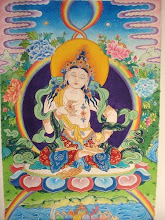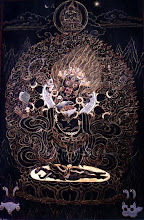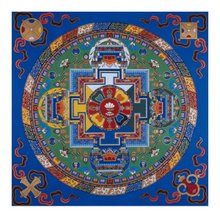An extended break seemed like a good opportunity to do something besides painting, something I wouldn't otherwise be able to do while school was in. So that same afternoon I set out in search of a yoga center that could take me on short notice for 5-7 days.
The tourist area of Thamel has a number of walk-in studios, but I was looking for something a little more serious, a little more intensive and extensive, a place where I could live, breathe and eat yoga for a few days. And that's what Ananda Yoga Center seemed to offer, a residential center located away from the commercial neighborhoods and run as a non-profit institution, suggesting the owners are more interested in teaching than in making money.
Cost
After a phone call to the center I was told no one was currently in residence and that I was welcome at anytime. A one-week all-inclusive stay was 13,000NPR, approximately US$178 for what turned out to be a half-day program of chanting, asana (postures), pranayama (breathing), and nidra (a relaxation technique).
Location
The center sits on the west edge of the Kathmandu valley, just beyond Kirtipur and Chobar, in a quiet residential and farming area.
As in most of Nepal, people here go to bed around 21:00 and rise between 04:00-05:00. Minibus service is available on the road immediately fronting the yoga center and will take you to the bus park at Kalanki or Ratna (in central Kathmandu). There is a small village near Ananda with what looks like a few small shops selling necessities. A larger village with the nearest pharmacy is about a 20-minute walk down the hill.
Facilities
The main building is a three-story structure with the yoga studio occupying the entire third floor, well lit by near floor-to-ceiling windows on three sides. The first two floors are rooms for residents, several with private squat style toilets and running water, a couple without.
Rooms are simple but clean and include beds and a low table appropriate for use while sitting on the floor. Some rooms have throw rugs. Because I was the only resident I had a room to myself, though most appear to accommodate 2 to 3 people. The first room I occupied was on the first floor on the side of the building and a bit damp in the evenings, so on request I was moved upstairs. All rooms have screens on the windows, but also have at least one window that cannot be shuttered, which might make for a chilly room in winter. Toilet odor was more noticeable on warmer days; you might like to bring along some incense. Showers are cold water only, though I was told hot water could be boiled on request (which I might have made had the temperatures been cooler).
There was plenty of insect life around the center, but I did not find nor hear of roaches or ants. Lighting is adequate, there is at least one electrical outlet in each room, and the center offers internet service over one computer and a rather slow dial-up modem. There is a small library of texts mostly on Yoga and Hinduism and the center takes a daily English-language newspaper subscription. There are no restrictions on what you may bring with you to the center (such as media players, computers, books, or your own food supply). The resident dog is completely nonthreatening – and quite sweet.
Food/water
A day after I arrived more guests began showing up. There were five of us by the time my week was up and nearly everyone commented positively on the food. As in much of Nepal, there is little variety outside the standard lentils, rice and curry (dal-baht-takari), but there is plenty of it and rather tasty as well. In deference to foreign clients, there are three meals a day (rather than the standard two for Nepalis), including a breakfast of fruit and a stiff, sweet wheat porridge. The center serves no meat, but seems willing to cater to reasonable dietary needs on request. Because the weather was fine during our stay, we took all our meals outside.
Be sure to ask about the water. Urban Nepalis typically filter their own, but often do not boil it, which was the case at the center during my visit. Mineral water is provided for guests. Make sure you determine which is which.
The program and instructors
During my stay there were three types of activities, each overseen by a different instructor. The morning began with an hour of mantra chanting directed by the yoga center's guru, Shiva Giri, a 53 year old Brahman who has been operating Ananda Yoga Center for 18 years and who studied in India with Niranjanananda Saraswati of the Bihar school of yoga. The morning services are attended by many members of Shiva Giri's extended family, so even if you happen to be the only resident, as I was for a day, there will be plenty of people around to help carry the chants.

After a 30 minute break, asanas, the physical postures most typically associated with yoga, were taught by Shiva Giri's 23-year-old daughter, Gangha, who has been studying yoga with her father since an early age and has completed teacher training in India.
Later in the day, just before lunch, a young man of approximately the same age, Surya, conducted one hour of pranayama, or breathing exercises. Surya is from the neighboring district of Kavre and beyond approximately four years at Aanada Yoga Center with Shiva Giri, I don't know of any other qualifications. Mid-afternoon we met with Shiva Giri for yoga nidra, a deep relaxation technique, before a pre-dinner hour of asanas with Gangha. There are two rather large gaps in the day, from about 09:00 – 11:30, and again from 13:00 – 17:00 (with 30-40 minutes of yoga nidra).
The review
Because I found Shiva Giri's family so open and genuine, I feel a bit uncomfortable offering criticism. But they are, after all, running a business. They are asking for your money. So you should know what kind of experience is being delivered. This is, of course, a summary of my experience only, though the main conclusion was corroborated by a fellow participant.
Surya one day said to me that yoga can't really be taught, that what we do is remind each other of how to do things. I assume by this he meant that the basics – the postures and the breathing techniques – are really quite simple. So simple that anyone can do them on their own. But in being together we can observe each other and point out errors or aspects that need additional effort or attention. Practiced together, the method is essentially self-correcting. As far as the exercises and breathing are concerned, this is a fair way of viewing the process.

Where teachers can help is in tying the exercises together, explaining why things are done in a certain way, how the exercises inform each other, and the ultimate purpose in doing them. In other words, being able to convey the philosophy of yoga. This was, to my great regret, the one thing missing from Ananda's program. It seems Shiva Giri thinks it is enough just to go through the motions without offering context.
Anyone who looks into yoga soon discovers that the postures are really a means to an end. Many western practitioners like to believe – and sometimes assert – that yoga is not a religion, and through semantic slight-of-hand that may be true. But yoga is most certainly a spiritual practice. The exercises are intended not only to maintain physical health, but to help the practitioner develop close attention to his or her own body, the vehicle through which we experience life. The practitioner in effect is exploring the universe through his or her body with the ultimate aim of experiencing the merging of self and object.
None of this was discussed at Ananda, a lost opportunity for students new to yoga. I think Shiva Giri might have liked to. He said that he enjoys discussing spiritual issues and rarely tires while on the subject. Unfortunately, his linguistic skills are not up to the task and he was forthright enough to say so himself. He was also quite self-effacing when it came to titles and it seems he has retained a critical attitude. Many people call themselves gurus these days, he said, but in fact few are. Even though a teacher is typically referred to by his pupils as Guru-ji, he insisted he was not. And when questioned about the seeming miracle powers of yogis and sadhus, his reply was that in every story there is most always a grain of truth that has been exaggerated beyond proportion by the practitioner, his students, or the public.
At minimum Shiva Giri should be giving an overview of the history of his yoga school and making sure each visitor to Ananda leaves with some knowledge of its founder and most important teachers. Shiva Giri studied in the Bihar school, a syncretic movement of recent origin about which I had to learn through a book from the center library. There were pictures of the school's two most prominent gurus posted in the yoga hall, and their names were mentioned a couple of times, but I suspect few people leave with their names on their tongues, and maybe not even in the back of their minds.
Altogether I was not disappointed in my week at Ananda Yoga Center. I met some wonderful people, learned some new asanas and pranayamas, improved my flexibility and balance, finished a painting and a book in my free time, played with a beautiful dog, and found lots of colorful insect life to photograph. It was a relaxing week, though I would have preferred a more heavily structured program with not only lots to do, but lots to think about.
Ananda Yoga Center is great place for those who want a relaxed yoga regimen without being bothered by philosophy, or who are looking for a quiet stay while in Kathmandu.
#































I know something about Yoga and would like to point out that the statement that the instructor (Surya) made that "yoga can't really be taught, that what we do is remind each other of how to do things." could also be seen on a deeper philosophical level than as merely a statement about learning the Yoga positions--the statement could also refer to the fact that Yoga is very "inner" and comes from nature, and that we can return to our own awareness of our own body-mind and live naturally again with ease through the awareness that comes from Yoga.Yoga is a way of life and is everything we do.It is also "inner" so cannot in a sense,really be taught by others. We need to find it ourselves (although it is useful to have some advice and help).
ReplyDeleteAbsolutely. Thanks for reading and for posting.
ReplyDeleteGreat review, thanks
ReplyDeletehello,
ReplyDeleteI read your comments. very exciting. I am in fact planning on taking a trip to this exact place, however, I do not see any comments beyond 2009, does this mean that no one visited the center after 2009?
thanks, Sylva
Sylva, I am interested in visiting this ashram too. There are many comments on the Ashrams own website both recent and old. Did you go and how was it?
ReplyDelete